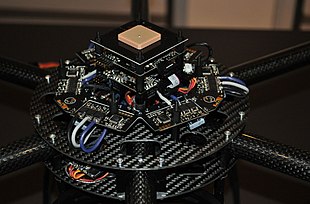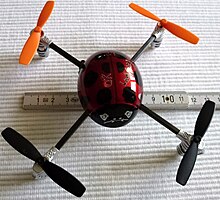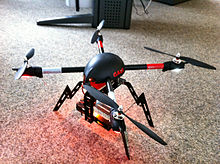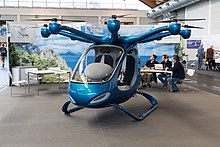Quadcopter

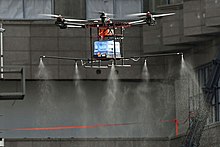
A Quadrocopter or Quadrokopter ( lat. Quadrum , rectangle 'and gr. Πτερόν pteron , wings'), also Quadricopter , Quad rotor , suspended platform or in general Multicopter is an aircraft which is arranged in a plane four, vertically acting below rotors or propellers used to generate lift and, by inclining the rotor plane, also propulsion . It is one of the helicopters and, like them, can take off and land vertically. Quadrocopters can fly more and more complex maneuvers. Swarms of these devices can hover in the air, fly in formations and autonomously carry out complex flight routines such as somersaults, flying through targets and self-organization in the group, as in the coordinated process when crossing a window frame in the group.
technology
Drive of quadrocopters
In the model making sector and for drones in quadrocopter design, the propellers are usually driven directly or via a gearbox by brushless DC motors or other DC motors. These are designed as external or internal runners and attached to the outer end of cantilevers. The electrical energy for these motors is usually provided by lithium polymer accumulators . This type of drive enables an astonishingly high payload despite the small size of the aircraft.
Control of the quadrocopter
Quadrocopters are usually built in a conventional configuration and configuration or H configuration (see figures in the table). The configuration is widespread and enables simple control, with only one pair of motors being controlled for changes in the longitudinal and transverse axes. With the - or H -configuration the motors are offset by 45 ° to the flight direction. For a rotation around the longitudinal or transverse axis, all four motors are to be controlled simultaneously. In addition, the direction of flight is not covered by a propeller when taking photos and videos.
In contrast to conventional helicopters, quadrocopters do not require any mechanical components such as swash plates , controllable pitch propellers or rudders for control . The propellers are permanently mounted on the engine or connected to it via a gearbox. Changes in lift are only made by increasing or decreasing the engine speed . If the speed of all motors is increased or decreased at the same time, the quadrocopter increases or decreases. Ideally, the quadrocopter should take off in the middle speed range of the engine and thus also in the middle propeller thrust range. This is the only way to have sufficient power reserves for difficult flight situations.
In quadrocopters, two propellers turn clockwise (red) and two counterclockwise (blue) . As a result, the torques transmitted from the propellers to the support frame cancel each other out as long as the sum of the forces of the left and right-handed propellers is the same and the forces are thus neutralized.
The rotation of the quadrocopter around the vertical axis ( yaw axis ) takes place in that the left and right turning propellers are controlled at different speeds. The neutralization of the torque is canceled so that the quadrocopter rotates around the yaw axis.
Rotations around the longitudinal axis ( roll ) or transverse axis (nod) take place through the different control of the motors on the respective other axis. The speed of the left or right rotating motors must be changed in inverse proportion so that the sum of the torques generated by them remains the same. Otherwise the quadrocopter would yaw.
The operator ( pilot ) of the quadrocopter does not have to worry about the configuration-dependent control variants. The operation of the transmitter of the radio remote control is identical for quadrocopters in configuration as well as for those in or H configuration. The control signals transmitted by the transmitter are transmitted by the receiver built into the quadrocopter to the control electronics specially programmed for the respective configuration, which, if necessary, regulate the speed of the individual motors taking into account the data transmitted by the stabilization electronics.
There is no drift in the overall system of the quadrocopter as in the tail rotor configuration of the helicopter. There are hardly any asymmetrical artifacts from gyro effects in the control.
| configuration | Change height | Vertical axis yaw | Nod across the axis | Roll the longitudinal axis | ||||
|---|---|---|---|---|---|---|---|---|
| climb | sink | right | Left | front | back | right | Left | |
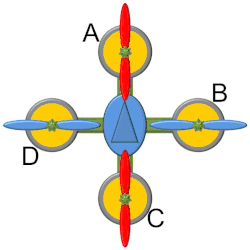 ➕ configuration |
ABCD prop. increase | ABCD prop. reduce | Increase BD and AC prop. reduce |
Increase AC and BD prop. reduce |
Increase C and A prop. reduce |
Increase A and C prop. reduce |
Increase D and B prop. reduce |
Increase B and D prop. reduce |
 × or H configuration (dashed) |
ABCD prop. increase | ABCD prop. reduce | Increase BD and AC prop. reduce |
Increase AC and BD prop. reduce |
Increase CD and decrease AB |
Increase AB and decrease CD |
Increase AD and decrease BC |
Increase BC and decrease AD |
In order to make the orientation of the quadrocopter in flight easier for the pilot to recognize (where is the front or the rear), the color of a propeller (in quadrocopters in - or H-configuration of the two) is usually designed differently. These different colors are intended to make it easier for the pilot to recognize the direction of flight of the quadrocopter. When this flies towards the pilot, the pilot has to rethink the controls. From the pilot's point of view, you have to steer to the left so that the quadrocopter flies to the right in the direction of flight.
Any thrust vector in space can be achieved by mixing the control commands. Depending on the design, quadrocopters can also fly loops , rolls and tight turns . In the past few years, miniaturization of the control and stabilization electronics in the leisure sector has brought very small quadrocopter capable of aerobatics and stable flying even in windy conditions onto the market.
Quadrocopters are usually not designed for high speed (exceptions are convertible aircraft in this design), but more for a stable flight position and easy operation of the controls. Most of the masses ( accumulators , control electronics, camera systems ) are concentrated in the center of the quadrocopter, which results in small moments of inertia in relation to the three axes of rotation (vertical, longitudinal and transverse axes), which allows high angular accelerations around these axes and therefore rapid changes in position and thus one enables rapidly changing thrust vector and thus ensures overall high maneuverability in flight behavior.
Stabilization through different beam alignments
Stabilization around the vertical axis can be achieved by rotating the four propellers in relation to the center of gravity. This has the advantage that all propellers can turn in the same direction. The control of the turning and tilting movement works in principle similar to that of rotors with different directions of rotation.
Electrical stabilization through gyroscopes
The basis for the further development of the model and UAV quadrocopters are advances in electronics and sensor technology, which were available on the market from around 2000 and appeared in series models from 2004: Powerful microcontrollers evaluate the data from gyroscopes and can thus achieve overturning moments - which are higher and occur more suddenly than with helicopters, since the center of lift is usually in the rotor plane - automatic adjustment.
Piezo- based gyroscope sensors or MEMS ( microelectromechanical systems ) are used to measure the angular speeds, which are used by the processor to regulate the speed of the electric motors , with which the aircraft flies stable. According to the current state of the art, MEMS gyros are advantageous as piezo sensors can react to different weather conditions and temperature differences in flight (sun and shade), which can lead to a restless flight.
Other designs use a mechanical gyro, the deviations of which from the starting position are recorded, for example, by Hall sensors ( inertial navigation system ).
The availability of small brushless motors ( brushless motor ), and lithium polymer batteries with significantly improved power to weight ratio allows viable flight times up to 30 minutes and record times to about 2 hours.
Since, apart from the motors, no mechanical parts such as servomotors , rods and rotor heads are necessary, this design is mechanically easier to implement than a helicopter.
On the basis of the existing microcontroller, additional sensors such as compass , altimeter or GPS also enable automatic flight control or exact positioning above ground.
Through the use of GPS modules, it is now possible for many semi-professional models, via Google Maps certain waypoints ( waypoints to set). The set points are transferred together with the maps to the naviboard of the quadrocopter. This begins the autonomous departure of the individual waypoints and, equipped with a camera, can take photos fully automatically at the waypoints. A GPS-supported coming home program ensures more safety, which lets the quadrocopter fly autonomously to the home point and land in the event of loss of reception.
Number and arrangement of rotors (multicopter)
In addition to the conventional configuration with four described above, there are also constructions with two, three, six, eight or twelve motors - sometimes in asymmetrical arrangements - whereby sometimes the failure of a drive is automatically recognized and corrected ( redundancy ). Models with six rotors are called hexacopters , with eight octocopters, with three tricopters and with two duocopters.
In tricopters , which save weight and components by restricting them to three motors, the yaw axis, which could not be controlled with three motors alone, is controlled by a motor mount pivoted by a servo .
With special duocopters, which only consist of two motors mounted in a vertical axis, additional components can be saved. It is controlled by the corresponding acceleration of the rotor blades for targeted thrust generation during one rotation.
Generally one speaks of multicopters .
development
At the beginning of the development of helicopters, a large number of rotors were often used because it was not yet possible to imagine a control system using a swashplate in practice. The French aviation pioneer Étienne Œhmichen had experimented with rotary wings as early as 1920, before his Oehmichen No. 2 lifted into the air. In this early quadrocopter, the four rotors were elastic and their angle of attack could be changed by twisting them with cables. In addition, eight horizontally acting propellers were used for stabilization and propulsion, as the rotors could not yet be controlled with sufficient precision. The Oehmichen No. 2 is considered the first reliable vertical take-off aircraft, completed more than 1000 flights and reached records on May 4, 1924 with a flight time of 14 minutes and a one-kilometer circular flight.
With the development of the swashplate and tail rotor , tandem and coaxial designs, the quadrocopter design disappeared from the field of vision of the developers. It was not until the general interest in VTOL vehicles in the 1950s that new quadrocopters flew again:
- Convertawings A from 1956, for the US Army, with tubular space frame, two motors and belt drive.
- The technically deliberately simple “flight jeep” Curtiss-Wright VZ-7AP from 1958.
- The single-seater Aerotechnik WGM 21 , which flew as a prototype in Germany in 1969.
- In October 2011 the start-up company Volocopter (original name: e-volo ) presented a person-carrying, electrically powered multicopter with 18 rotors. In 2018, the ADAC -Luftrettung announced that Volocopter will be tested in the rescue service in model regions in Bavaria and Rhineland-Palatinate.
- In April 2017 at Aero-Friedrichshafen, the French company EAC presented the two-seater, electrically powered octocopter EAC-Whisper.
Also convertible aircraft with Tandem airfoils and four rotors are controlled in hover (helicopter mode) as Quadrocopter. Examples are:
- The Curtiss-Wright X-19 with tilt rotors (1963) intended for fast passenger transport .
- The VC 400 transport aircraft , which was developed in Germany from 1963 onwards , but which did not get beyond the planning stage.
- The Bell X-22 experimental tilt rotor aircraft (1966).
commitment
After the experimental designs in the 1950s, no further passenger-carrying quadrocopters were developed for a long time. In combination with the autonomous operation of unmanned multicopters, however, there have recently been developments that are promoting the use of multicopters for passenger transport. The Chinese company Ehang, for example, is building the Ehang 184, an autonomously flying transport drone for passenger transport. In the aerodynamic sense of a rotor , the drone is a quadrocopter. However, the drone has eight propellers - one above and one below for each engine. The aircraft has a weight of 200 kg. The maximum load is 100 kg. Accordingly, the cabin is built for the transport of one person. With a travel speed of 100 km / h and a flight time of 23 minutes, the intended area of application is for commercial (air) taxi companies in cities and their surroundings. In order to save space, especially in urban areas, the rotor arms can be folded in. In this case, the Ehang 184 fits into a normal parking lot. Nevertheless, the most widespread application of the quadrocopter is found in aerial photography and videography.
In addition to the commercially available devices with remote operation, more and more private projects and in-house developments are emerging. Another application besides aerial photography is fun and aerobatic flying. Aircraft for this are based on the same basic components, but are configured differently in terms of mass and performance . Some of the quadrocopter in the hobby sector (like the Parrot AR.Drone ) can be controlled using the motion sensor in the smartphone or tablet, so that operation can be learned quickly and intuitively. Various universities are also working on the concept of having robust and inexpensive test objects available, for example for research in the field of swarm behavior .
In connection with FPV (First Person View), multicopters are also used as sports equipment: the normal FPV flight is combined with FPV glasses . This is how the pilot sees from the camera of his drone. This sport first developed in the USA, but there have also been various competitions (drone races) in Germany.
Quadrocopter drones are also used in the military. In addition to the large drones, such as the General Atomics MQ-9 , quadrocopters are also used in the military. These are then mostly used for clarification in difficult-to-access crisis areas. Quadrocopters can also be beneficial outside the military. Thanks to the load capacity of the quadrocopter, which can be several kilograms, victims of the disaster can be provided with essential aid packages before the rescue teams can be on site. Elsewhere, quadrocopters are also used to examine house facades for cracks in order to detect possible dangers earlier.
In December 2010, the German Federal Minister for Consumption, Ilse Aigner, took up the subject of data protection when transmitting images using drones. She took the view that private operators would "quickly reach their legal limits". A spokesman for the Federal Data Protection Commissioner stated that the deployment represented a legal gray area.
In the context of the controversial EU project INDECT , research is also being carried out into the use of camera-armed drones to "increase the security" of citizens against crime. The drones are designed to automatically identify and track people who have “acted suspiciously” in public and are networked with each other by radio.
In 2013, several shipping companies announced that they would test parcel deliveries with drones. Deutsche Post AG carried out a demonstration flight with its parcel service DHL in December 2013. Medicines were delivered to employees of Deutsche Post using a quadrocopter. In the meantime, the island of Juist is supplied with medicines and other urgent goods every Friday with the DHL parcel quadrocopter . It is the first commercial pilot of its kind in Europe.
Incidents
- On October 12, 2017 is passenger plane at the international airport of Quebec collided with a drone. Transport Minister Marc Garneau spoke of the first collision of a passenger plane with a drone in his country. The collision caused only minor damage to the aircraft operated by the Skyjet airline , as the Canadian Ministry of Transport announced. According to the minister, the accident could also have had catastrophic consequences if the drone had collided with the cockpit or the engines . The drone collided with the airliner at a height of 450 meters.
- On April 28, 2018, according to a statement by the pilot of a police helicopter, he had to avoid a drone at around 5.30 p.m. at a height of 200 m "at the last second" before landing at the Vienna Meidling barracks. The drone was then landed by the owner, who drove away with it in a car. The helicopter pilot observed this and stopped the car and its driver from Slovenia. According to the illustration (30 cm comparative scale) including the rotor circles, the approximately 90 × 90 cm large drone weighed over 250 g and, contrary to the obligation that has been in force since 2014, was not approved in Austria. The Slovenian stated that he tried the drone and landed because of the arriving helicopter. The helicopter pilot said that a drone of this size could cause the helicopter to crash “in the worst case”.
- On December 19, 2018 at 9 p.m. GMT, flight operations at Gatwick Airport were temporarily suspended. One or more drones were spotted repeatedly over the airport premises. On December 20, 2018, flight operations were briefly possible in the morning at 3 a.m. for around 45 minutes. After that, air traffic was stopped again because at least one drone was spotted again. On December 21, 2018, flight operations resumed at 11 a.m., however, after another drone sighting at 5:10 p.m. local time, it was interrupted again for almost an hour and a half. As a result, the British military installed jammers that allowed safe flight operations.
- On December 26, 2018, the use of fire-fighting planes to fight a bushfire near the Tasmanian capital Hobart was canceled by a drone sighting. The extinguishing work was then continued and ended from the ground.
- On January 8, 2019, flight operations at London Heathrow Airport were suspended for around an hour at around 6 p.m. due to the sighting of a drone .
- In 2019, two logistics drones from the Swiss Post and one from the Duisburg fire brigade also crashed.
Approval requirement
Europe (EU)
On November 30, 2017, the EU states and the European Parliament agreed that even small drones must be officially registered individually by the owner in the future.
Germany

As a rule, quadrocopters, unmanned aerial vehicles, drones and similar constructions such as octocopters, hexacopters etc. can be used without a permit up to a take-off weight of 5 kg ( Section 21a, Paragraph 1 of the Aviation Ordinance ) (LuftVO). It should be noted, however, that the operation of unmanned aviation equipment out of sight (without special optical aids) of the controller is fundamentally prohibited ( Section 21b, Paragraph 1, No. 1 LuftVO).
A distance of 100 m must be kept to the following areas: hospitals, federal highways, motorways, railway systems, federal waterways, disaster areas, prisons, power plants, crowds, nature reserves, barracks, police stations, police or military locations, embassies, consular missions, energy generation and distribution systems ( § 21b Abs. 1 LuftVO).
In particular, the regulations for restricted flight areas must be observed. There is a scalable map for Berlin with two airports and the government district.
From October 1, 2017, drivers of devices with a take-off weight of more than 2 kg must prove their technical and legal knowledge, provided that the take-off does not take place on recognized model airfields ( Section 21a, Paragraph 4 LuftVO). If the exam is not passed, it can be repeated twice. If the examination is not passed on the third attempt, the examinee can only repeat the “drone driving license” after a period of 2 years. ( Section 22 (4) LuftVO).
Pilots of unmanned aviation systems with a total mass of up to 10 kg without an internal combustion engine must submit a general order for permission to climb as a declaration.
The laws have also been revised with regard to mandatory labeling. From October 2017, every camera drone with a take-off weight of more than 0.25 kg must be provided with a sign, which can be used to clearly identify the owner in the event of damage or loss. The new legislation stipulates that the badge must be fireproof, visible and permanently attached.
A flight in the 1500 m wide protection zone in front of the fence of the 16 international airports is generally prohibited. At all airports, airfields and heliports, flying within the 1.5 km zone is always subject to a permit ( Section 21a (1) No. 4 LuftVO).
Outside the 1500 m distance, every aircraft that flies into the control zone of different lengths requires a clearance from German air traffic control . For model aircraft and private drones weighing less than 5 kg, a maximum altitude of 30 m is permitted, for businesses with UAS up to 25 kg, a height of 50 m is permitted. Deutsche Flugsicherung has given a blanket clearance within this control zone for these borders.
If such an aircraft is not used for sports or recreational purposes, an ascent permit is required . This is especially true for commercial aerial photography and other activities that arise for commercial reasons.
Air liability insurance has been mandatory for unmanned aircraft since 2005 (usually called drone insurance by insurance companies ), this is regulated by the Aviation Act (LuftVG), Section 43 (2). It is irrelevant whether the drone is used privately or commercially. Any damage, on the other hand, is usually not covered in private liability insurance if it only relates to toys. In any case, a drone is an aircraft and is in no way considered a toy. However, there is a legal gray area: the legislature does not precisely define the point at which a flying object is considered a toy. Many of the drones used should no longer be considered toys; In this case, their operators must take out their own insurance.
Around 400,000 drones had been sold in Germany by 2016.
Austria
Quadrocopters are treated the same as model airplanes as long as they weigh less than 15 kg and are used “only for personal enjoyment”. This means that flight recordings (photo and video) may only be used privately. There are opinions that publishing on Facebook etc. is not allowed either.
LFG (January 1, 2014): § 24c. (1) Flight models are unmanned devices that are not used for national defense and that can be used independently in flight with a direct line of sight to the pilot without technical aids and
- within a radius of no more than 500 m and
- operated exclusively free of charge and non-commercially in the leisure sector and exclusively for the purpose of the flight itself.
For film and photo recordings, the provisions of the Data Protection Act also apply.
Proof of insurance for liability insurance for 750,000 euros is required for a drone permit .
Switzerland
Objects in flight up to 30 kg may generally be operated without a permit if they have visual contact. Operation using technical aids is permitted if a second person is observing the flying object and can intervene in the controls in case of doubt. Quadrocopters may only be operated at a distance of at least 100 m from a gathering of people. Furthermore, aircraft may not be flown closer than 5 km to an airfield runway.
The operator of a quadrocopter over 500 g must take out liability insurance for at least one million Swiss francs .
From June 2020, Switzerland will take on the EU's registration obligation.
Muscle power flight
Of the muscle power helicopters , the Gamera (I) (2011), Gamera (II) (2012) and Atlas (2013) are quadrocopter. However, Da Vinci III , which took off in 1989, has only one rotor.
See also
literature
- Roland Büchi: Fascination with quadrocopters . 1st edition. Verlag für Technik und Handwerk, vth, 2010, ISBN 978-3-88180-791-3 .
- Thomas Riegler: Adjust the quadrocopter correctly and fly. Franzis, Poing 2011, ISBN 978-3-645-65073-1 .
- Christian Rattat: Build your own multicopter: Basics - technology - own models. dpunkt-Verl., Heidelberg 2015, ISBN 978-3-86490-247-5 .
- Stefan Neudorf: Aerodynamics and technology: that's why the multicopter flies. In: Drone Magazine , No. 1/2017, pp. 42–43
- Günter Neumann: Civil drone technology: flying helpers for many purposes. In: FliegerRevue , No. 3/2019, 67th year, pp. 16-18
Broadcast contributions
- Maximilian Schönherr : Rules for the lower airspace - already threatened today? , Deutschlandfunk - " Science in Focus " on January 21, 2018 and the overflight of St. Lambertus (Immerath)
Web links
Individual evidence
- ↑ Martin Saska, Jan Vakula, Libor Preucil: Swarms of micro aerial vehicles stabilized under a visual relative localization . In: Proceedings - IEEE International Conference on Robotics and Automation . May 1, 2014, p. 3570–3575 , doi : 10.1109 / ICRA.2014.6907374 ( researchgate.net [accessed June 19, 2018]).
- ↑ UPenn's GRASP lab unleashes a swarm of Nano Quadrotors. Accessed June 19, 2018 .
- ↑ a b c d e f g n. N .: crosswise. Multicopter - what is it? In: RC-HeliAction , No. 9, 2012, Wellhausen & Marquardt Mediengesellschaft, pp. 46–50.
- ↑ Longest RC model multicopter flight (duration). Retrieved March 20, 2016 .
- ^ Volocopter website
- ↑ ADAC Luftrettung is examining the use of manned multicopters. Retrieved July 26, 2020 .
- ↑ Columbus Interactive GmbH www.columbus-interactive.de: AERO | AERO Friedrichshafen. Retrieved July 26, 2020 .
- ↑ Whisper. Retrieved July 26, 2020 .
- ↑ Chinese manufacturer develops personal transport drone. May 10, 2016. Retrieved August 22, 2016 .
- ↑ Quadrocopter test by Stiftung Warentest with video. In: test.de , July 12, 2012.
- ↑ Drone racing as a new sport. In: welovedrones.de. April 1, 2016, accessed August 22, 2016 .
- ↑ Data protection - Aigner is targeting mini drones. In: Heise.de , December 26, 2010.
- ↑ Benedikt Fuest: DHL is testing parcel delivery by drone for the first time . December 9, 2013. Retrieved January 10, 2014.
- ↑ Danielle Elliot: DHL testing delivery drones . December 9, 2013. Retrieved January 10, 2014.
- ↑ DHL starts unique quadrocopter pilot project in Europe . September 26, 2014. Retrieved September 26, 2014.
- ↑ Passenger plane in Canada collides with a drone. FAZ , October 16, 2017, accessed on July 18, 2020 . .
- ↑ Police helicopter almost collided with drone orf.at, April 29, 2018, accessed April 29, 2018.
- ↑ Drones ground flights at Gatwick . In: BBC News . December 20, 2018 ( bbc.com [accessed July 26, 2020]).
- ↑ London Gatwick Airport paralyzed. In: srf.ch . December 20, 2018, accessed December 20, 2018 .
- ↑ Police are considering shooting down the Gatwick drone , accessed December 20, 2018
- ↑ Gatwick runway reopens after drone chaos. BBC News, December 21, 2018, accessed December 21, 2018 .
- ↑ Disruptive actions: New drone over Gatwick - airport stops operating . In: Spiegel Online . December 21, 2018 ( spiegel.de [accessed December 21, 2018]).
- ↑ bbc.co.uk
- ↑ Tages-Anzeiger - Gatwick Airport reopened - search for perpetrators continues , accessed on December 21, 2018
- ^ Frankfurter Allgemeine Zeitung - Drone hinders the use of fire-fighting aircraft , accessed on December 26, 2018
- ↑ Drone alarm paralyzes London Heathrow Airport for an hour. In: watson.ch . January 8, 2019, accessed January 9, 2019 .
- ↑ Above a piece of forest - Another post drone crashed in Zurich. In: srf.ch. May 9, 2019, accessed November 23, 2019 .
- ↑ The Duisburg fire brigade's high-tech drone crashed. In: radioduisburg.de. November 23, 2019, accessed November 23, 2019 .
- ↑ Drone registration soon everywhere in EU mandatory orf.at, November 30, 2017, accessed on November 30, 2017.
- ↑ Use of flight models in Berlin , further additions to FIS brokers (national maps) .
- ^ Government of Upper Bavaria: Unmanned aviation systems ("drones"). Retrieved June 20, 2017 .
- ↑ BMVI - Clear rules for the operation of drones. Retrieved September 29, 2017 .
- ↑ Drones endanger air traffic. ( Memento of the original of June 21, 2017 in the Internet Archive ) Info: The archive link was automatically inserted and not yet checked. Please check the original and archive link according to the instructions and then remove this notice. In: dfs.de
- ↑ dfs.de ( Memento of the original from June 15, 2015 in the Internet Archive ) Info: The archive link was inserted automatically and has not yet been checked. Please check the original and archive link according to the instructions and then remove this notice. .
- ↑ Information from the Federal Ministry of Transport, Building and Urban Development about unmanned aviation systems. In: strassenbau.niedersachsen.de
- ↑ § 20 Paragraph 1 No. 7 Aviation Regulations , § 1 Paragraph 2 No. 11 Aviation Act .
- ↑ GDV: Why private pilots have to insure their drone. Retrieved March 22, 2016 .
- ↑ Westfälische Nachrichten : Permanent danger in air traffic: Pilots warn of collisions with drones - Incident at Heathrow Airport , From all over the world, Frankfurt / Main, dpa , April 19, 2016
- ↑ Information Austro Control
- ^ RIS - Aviation Act - Consolidated Federal Law, version dated November 13, 2017. Retrieved November 13, 2017 .
- ↑ a b Information from the Federal Office for Civil Aviation regarding drones and model aircraft. In: bazl.admin.ch
- ↑ Switzerland adopts EU law - now the registration requirement for drones comes. In: srf.ch . August 22, 2019, accessed December 27, 2019 .

